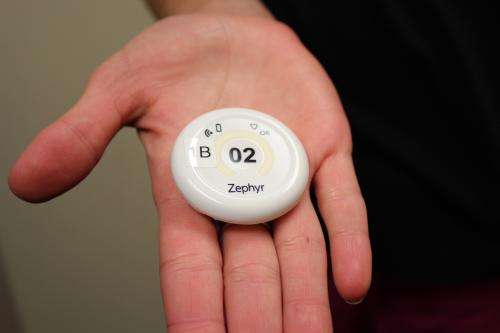Sensors may keep hospitalized patients from falling

(Medical Xpress)—To keep hospitalized patients safer, University of Arizona researchers are working on new technology that involves a small, wearable sensor that measures a patient's activity, heart rate, wakefulness and other biometrics – data that can predict a fall before it happens.
More than 500,000 hospitalized patients fall each year in U.S. hospitals, resulting in 150,000 injuries, according to an estimate from the National Patient Safety Foundation.
The problem prompted Cindy Rishel, the University of Arizona Medical Center's administrator of nursing research and practice, to find a solution.
"We currently use the Heinrich II fall risk assessment to determine patients' risk for falling," Rishel explained. "But it's not as thorough as we'd like, and often our assessment of risk is subjective when based on patient self-reporting."
Bijan Najafi, UA associate professor of surgery, medicine and engineering and director of the interdisciplinary Consortium on Advanced Motion Performance, or iCAMP, along with his team of engineers, welcomed the challenge.
In the study, Najafi and his team are using Zephyr BioModule sensors to continuously track patients' skin temperature, physical activity, heart rate, respirations and echocardiogram readings. The more than 2 gigabytes of patient data collected daily per sensor is then plotted against an algorithm that estimates fall risk.
Zephyr Technology, based in Annapolis, Maryland, agreed to lend UAMC the equipment and technology for the study, with any additional costs and staff time provided by iCAMP, an interdisciplinary research and development collaboration among a host of teams, including podiatric and vascular surgery, orthopedics, nursing, geriatrics, anthropology and engineering at the UA.
The technology will collect a massive amount of data regarding patient activity while in the hospital, and will help more accurately pinpoint which patients are most likely to fall. Although the study is solely collecting data for this phase, eventually the system could be used to alert nursing staff or even a family member when a fall seems imminent.
The yearlong study began in September 2013 in a hematology/oncology unit at UAMC – University Campus. The population was chosen for its typically longer hospital stays and increased risk for falls and bleeding.
"Our patients enjoy being a part of research studies because they understand these things strengthen our ability to care for them," said Jessica Schroder, a UAMC registerd nurse and clinical leader of the unit involved in the study. "The Zephyr sensor is small and lightweight, and our patients like that it doesn't beep or blink at them like many other things they get hooked up to."
So far, 43 patients have participated. Najafi and Rishel are in the process of requesting an extension to allow them to involve 100 participants and further strengthen their findings.
"We are lucky to have the support of the nursing staff in the participating unit, which is key to ensure the final product is patient-centric," Najafi said.


















